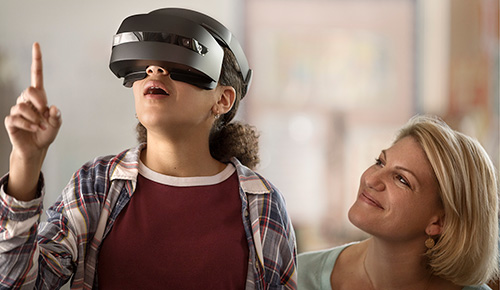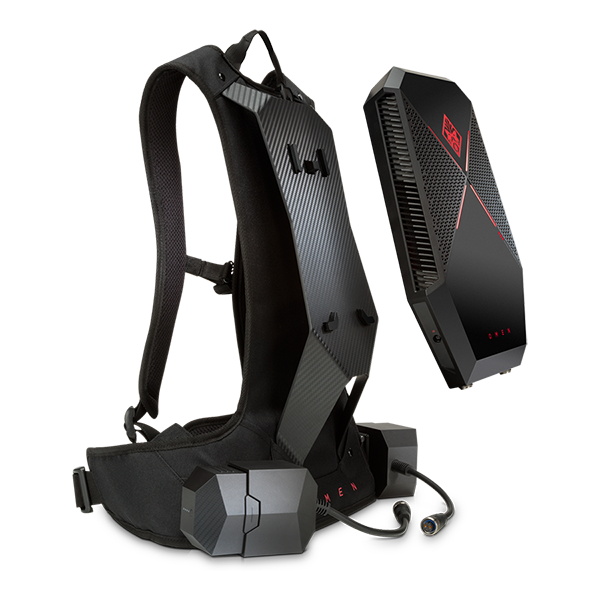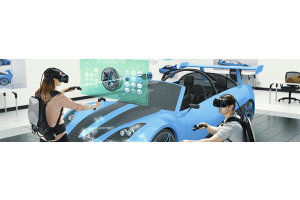We use cookies to offer you a better experience. For more information on how we use cookies you can read our Cookie and Privacy Policy.
What is Virtual Reality (VR) and How Does It Work?

There are many ways to answer questions like “what is virtual reality?” and “how does it work?” as the technology evolves. New companies are constantly springing up to ask and answer those very questions in different ways, while developers are finding new applications to explore in this exciting space.

In the context of gaming, virtual reality generally refers to computer-generated 3D environments. The level of interaction depends on the context of the game you are playing and how the headset and controllers allow you to enter into that game.
In industry, we are just beginning to scratch the surface of what we can do and imagine with virtual reality.
The advantage and appeal of VR in gaming is the opportunity for truly deep immersion. The perceived impact changes depending on how the system balances your sensory input with both physical cues and different visual stimuli.
VR trends in 2018
As of early 2018, the technology and types of experiences generally depend on an increasingly recognizable array of user tech, such as projectors, headsets, and motion-tracking. There are even some forms of sensory technology that use kinesthetics to convey information to users physically.
VR setups that are capable of providing a higher level of sensory data to the user are called haptic systems. “Haptic” stems from the Greek word “haptos” for learning actively through a tangible encounter, such as touching an object, exploring a surface, and so forth.
These systems are complex but highly immersive, so much so that they’ve already found a range of uses in gaming, but also in other unrelated areas. In fact, similar technology is often used for recovery from injuries and physical therapy procedures, and even military training.
Whatever way you imagine the term virtual reality, the technology is in constant flux, encompassing new and exciting possibilities to experience every year. Even the popularity and reach of games like Pokémon Go, which combine a virtual experience with real life, show just how much impact is possible with a careful design to create a compelling experience.
Types of VR
Traditionally, there are two primary development pathways that VR has tended to follow: stationary and mobile.

Mobile
Mobile is more accessible, with the format based heavily on smartphones and depending to some extent on their built-in features. With an investment of under $100 if you already own a smartphone, you can get a Google Daydream View to access games, puzzles and short videos.
By spending a bit more, you can step up to something like the Oculus Go or HTC Vive for a more robust virtual experience. But as new technology develops, VR is not just a component of your smartphone.
At HP®, we offer an intermediate design in the form of our wearable HP Z Virtual Reality (VR) Backpack PC, which allows a much richer VR experience while keeping the mobility of a cordless setup.
Stationary
Stationary VR technology often uses stand alone multi-projector setups in a fixed space. These involve a headset along with motion-detecting technology, such as gloves and controllers, depending on their sophistication.
Given the additional components involved, this is the more expensive of the two types of VR, but tends to be more immersive, giving rise to wider applications beyond the gaming industry. Regardless of cost, the market continues to expand and add new options.
How does virtual reality work?
Both types of VR are related, thanks to the motion-sensing components that have made the average system more usable for consumers and more adaptive for developers. You can find many VR-ready products depending on your intended use.
Head tracking
Both mobile and stationary VR depend on head tracking provided by the headset displays built to render 3D environments in VR, sometimes with a boost from audio components.
Using these headsets, your view of the environment follows the angle of your head so that you can absorb your surroundings naturally. Making a user’s motions feel seamless is the basis of truly immersive VR, so a gyroscope is typically used to keep the system and user in sync while a barrier between each eye simulates depth.
The barrier or division works by creating a stereoscopic effect that tricks the brain into perceiving the scene as more realistic and tangible. Typically, the effect is achieved through the use of two separate displays, one right and one left, or a simple split-feed that’s been divided into two streams. Tracking the orientation of your head - and in some cases, your eyes - is critical to most VR applications, so these are indispensable and universal elements within the technology.
Eye tracking
Eye tracking is another important feature being incorporated into newer VR headset models, with infrared scanners tracking where the user’s eyes are looking. While these systems aren’t critical to most setups, they increase a developer’s spectrum for realism by making it possible to simulate the natural blur and deformation associated with focusing on one object or plane versus another.
These headsets also contain special lenses to prevent strain on the eyes and to keep images properly focused. Coupled with a powerful enough system to provide a good field of view and a high frame rate, these devices provide the immersion that makes VR technology so compelling.
The history of VR
Past forays into the world of VR have been colorful and varied, like the elaborate sensorama system imagined by filmmaker Morton Heilig in the 1950s. He used a viewing hood as an enclosure, fans, a moving chair, stereo sound, and a color display to produce an immersive, truly multimedia experience in the form of several films.
Other important components used in modern systems were developed even earlier, like the invention of the stereoscope in 1838. And then there were the rapid advances in optics in the 20th century, which contributed greatly to improvements in the lenses that are so crucial to VR headset design.
Most of the early applications for VR were utilitarian, developed continuously by government scientists for various training projects, although headset displays also appeared periodically. Otherwise, it wasn’t until the late ‘70s and ‘80s that most of the developments underpinning today’s format took place.
The exploration of VR applications for entertainment has only accelerated in the 2000s, spurred in part by innovation around mapping and smartphone technology.
Virtual reality versus augmented reality
Thanks to the relatively recent development of accessible VR technology, some of the associated terminology are still being defined.
Even the term “virtual reality” has seen varying uses. It ultimately displaced the expression “artificial reality” used by pioneering interactive tech developer Myron W. Krueger when he wrote some of the most rigorous early examinations of the field.
Frequently, you’ll hear the term “augmented reality” (AR) associated with VR, though it refers specifically to the practice of superimposing peripheral data over a visualization of real-world environments.
AR also describes the premise for many contemporary video games or future scenarios, with augmented players experiencing environments in-game from their own unique perspective. The technology involved is still fundamentally related though and has been used in the form of wearables like smart glasses.
Other VR applications
As the systems that help create compelling virtual reality experiences develop, the primary applications have remained entertainment and gaming in particular although use for VR in business applications is growing.
VR in entertainment
For years, different forms of VR experiences have been common at theme parks or resorts that sometimes use their own custom physical props or landscapes to flesh out details and add novelty.
While full VR suites and multi-projector systems remain prohibitively expensive for most casual users, tech companies have developed lower-tech configurations that offer a more minimal, but still thrilling, experience.
Standalone VR headsets have been used to create augmented reality and virtual reality experiences in Google Maps, Pokemon Go, and other apps. Essentially, they link existing infrastructure and technology to create a new viewing experience.
VR in pro sports
The realm of professional sports is a growing sector of interest as well. Major corporations and a slew of start-ups are banking on the possibility of fans enjoying a more immersive experience of their favorite teams and events.
Most sports programming actually already incorporates augmented reality elements, like the Virtual Yellow 1st & Ten® graphics system introduced by ESPN and the NFL in the late ‘90s. Using motion sensor and a variety of data gathering tools, Virtual Yellow 1st & Ten® visualizes first-down lines and other elements of play to help viewers follow the action during football games. The system can even compensate for visual distractions like snow and rain during extreme weather.
When it comes to pro sports, VR development has centered on creating accessible experiences, such as using 360-degree cameras to stream events. The approach is appealing at this stage in VR tech because it would rely on only a simple headset and app system. It also has a lower cost compared to projectors, making it easier to test and introduce, though it does depend on physical installations at arenas and events.
More long-term goals for sports VR include the possibility of expanding beyond the stationary in-game experience. Imagine watching your favorite player making a spectacular play, only for you to jump into a replay that puts you in their shoes.
That interest has intensified in recent years, with motion capture and powerful new camera systems allowing games to be quickly re-rendered in an immersive 3D environment. Although the timeline for new developments is long, we’ve already moved beyond the more complex procedures around mapping unique event spaces to more subjective elements, like guidance visuals and even advertisements.
For now, most experts predict the possibilities for virtual reality will expand exponentially as tech developments make lower cost systems more common for both users and developers.
The future of VR gaming technology
In the context of VR games in particular, there are still massive expectations for how virtual reality can improve and how the associated experiences can be more in-depth, more immersive, and more connected to your own sensory experience.
Broadly speaking, the VR bandwagon has grown as VR systems have become more common and affordable. More and more companies are developing their own multi-projector systems and with the technology’s expansion to sport and athletic applications, it’s easy to imagine a playability payoff as the user experience is explored more thoroughly.
For video game and console developers, the future of VR is only constrained by the imagination. The HP OMEN gaming laptop series is one example of how the VR experience can make gaming more immersive than ever.

While developers may certainly want to create the most distinctive games to stand out, the goal here is primarily immersion. As in, how to make a game feel more complete, seamless, and whole. The ways in which this can happen can only be answered as the technology gains more popularity, so that developers can see how consumer preferences play out on a large scale and a long timeline.
Also, the concept of physicality in VR should grow side-by-side with the greater technology that has already been implemented in gaming PCs and consoles. Each has its own interactive, motion-detecting features and accessories, and some even have their own integrated headset.
It’s all part of a greater goal to create experiences that feel truly real and more compelling, and where you can dynamically interact with other gamers and objects.
Whatever the future holds for VR, it’s sure to be an absolute blast.
About the Author: Dwight Pavlovic is a contributing writer for HP® Tech Takes. Dwight is a music and technology writer based out of West Virginia.






